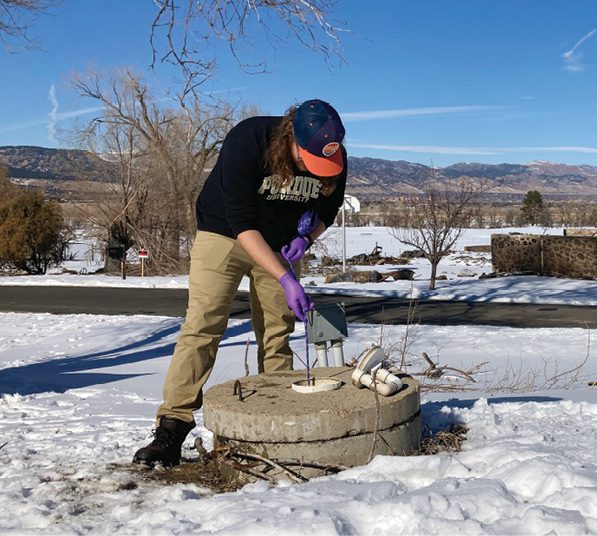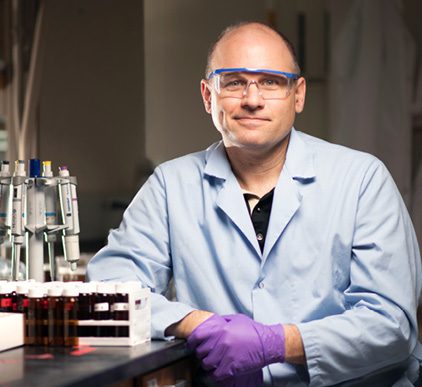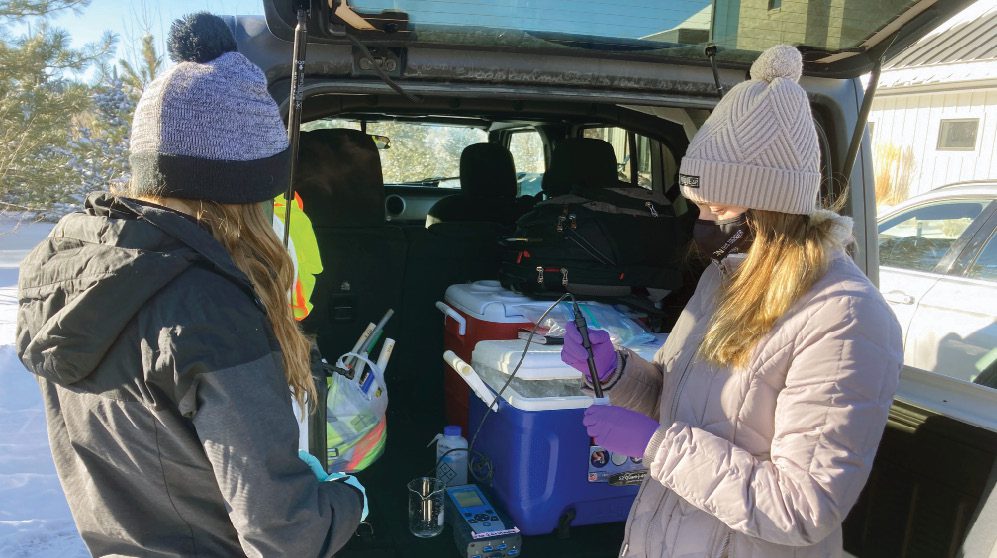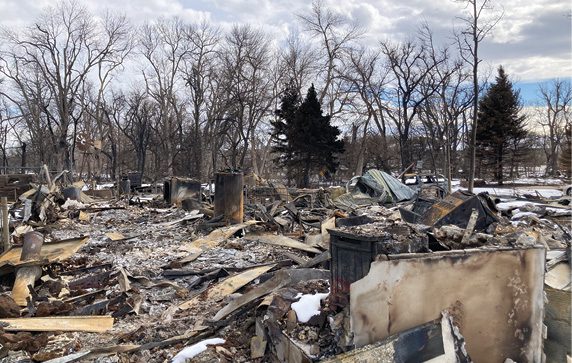Wildfire Endangers Drinking Water: Lessons from Colorado’s Marshall Fire

Private wells are particularly vulnerable to contamination from wildfires. Whelton and his students spent a week in January 2023 conducting free water testing for these wells in the Louisville, Colo., area. Pictured is Kristofer Isaacson, a Purdue graduate student in Environmental and Ecological Engineering. (Purdue University photo/Andrew Whelton)
Globally and domestically, wildfires can cause public health and safety risks and are increasing in intensity as well as the number of acres burned, according to research by Andrew J. Whelton, a Purdue University professor of civil engineering and environmental and ecological engineering who also taught a disasters and emergencies class at Purdue.

Andrew Whelton, a professor at Purdue University, is helping communities decontaminate water systems more quickly following wildfires.
The fastest-growing land use is wildland-urban interface, where human development intermingles with vegetative and wildland fuels, putting more than 46 million residences in 70,000 communities at risk. Wildfires annually cause hundreds of millions of dollars of property damage, including to public drinking-water systems.
Research indicates a lack of safe water during recovery can lead to business closures, financial and other hardships on residential households, and mental-health impacts.
Case in Point
The 2021 Marshall Fire was the costliest fire in Colorado’s history, destroying more than 1,000 homes and businesses, displacing more than 40,000 people and damaging six public drinking-water systems.
The incident begs the following questions:
• What are the driving factors in drinking-water system damage after a wildfire?
• What needs to be done to mitigate those challenges?
These questions are explored indepth through “The Marshall Fire: Scientific and Policy Needs for Water System Disaster Response,” a case study and research published in January 2023 by the American Water Works Association. The study documents the initial response and recovery actions of the six public water systems impacted by the Marshall Fire.
Key events during the first 24 hours of the response primarily pertained to maintaining water pressure and basic operations.
“It’s a good case study, because the Marshall Fire response by the community, leaders and the state is a template for how other people can do it right,” says Whelton. “It was the most-positive disaster response I’ve been part of. They were openly and honestly looking for any and all scientific information to better inform their decision-making process.”
At the request of Louisville, Colo., and Superior, Colo., five days after the Marshall Fire disaster, Whelton provided onsite technical assistance and led a case-study team, including collaborators from the University of Colorado, Boulder; Oregon State University; Corona Environmental Consulting; and the U.S. Environmental Protection Agency. Funding was provided by the U.S. National Science Foundation, the Water Research Foundation and Louisville. The goal was to better understand decisions, resources, expertise and response limitations during and after the wildfire.
“It’s my opinion the people in Colorado recovered more rapidly from the Marshall Fire than any other wildfires I’ve seen because their leaders applied a very good approach to protecting public health and restoring the water system,” explains Whelton.
“By getting experts onsite, we were all able to inform them about what they should look for and what they shouldn’t look for,” he adds. “The municipalities and the engineering teams for the municipalities were able to then immediately implement those recommendations.”
According to Whelton, the most-important step a water utility can take is to prepare its staff to respond to damaged infrastructure, know the system and have available maps that don’t require internet access because power will be lost during disasters. Power loss also cripples the ability to treat drinking water, so diesel-based backup generators are important to keep a water-distribution system pressurized.

Caroline Jankowski (left), a Purdue graduate student in Environmental and Ecological Engineering, and Christian Ley, a University of Colorado Boulder postdoctoral associate and Purdue Environmental and Ecological Engineering alumna, test water samples collected from Colorado’s Marshall Fire.
“In the initial phase of the disaster, the fire attacks the water system, and the utility infrastructure burns down,” he says. “Water starts leaking out of the distribution system. Once you lose power, you lose the ability to produce water to keep fighting the fire and pressurize the water system.”
Contamination can get sucked back into the water system, adds Whelton.
Entities with natural-gas generators need to be mindful the natural gas company is going to shut off their generators during a fire, as happened in Colorado. “Their facilities couldn’t treat any new drinking water even though they were on emergency power supply,” he adds.
Whelton says a second priority after a fire is to know who to call as well as how to test and what to test for in a water-distribution system.
Loss of power to the water systems impacted by the Marshall Fire was sometimes coupled with structural destruction, distribution depressurization and backup-power system failure. This jeopardized firefighting support, allowing for volatile organic compound (VOC) and semi-volatile organic compound (SVOC) water-distribution-system contamination, the study notes.
Look for Help
At the request of Louisville and Superior, assistance from neighboring systems and external technical experts enabled water-system staff to stabilize the infrastructure, locate and remove the contamination, and restore services. Smaller utilities don’t have such a network, however, and are primarily dependent upon state agencies for technical advice.
“They may have part-time staff,” Whelton says of smaller utilities. “Some of them may not even know where their pipes are. When the small utilities are damaged, they take much longer to recover.”
Whelton notes Louisville and Superior regained control of their water-distribution system three months after the fire, having identified and restored contaminated assets.
Create and Follow an Action Plan
The study identified actions for utilities, governments and researchers to help communities minimize wildfire impacts, better protect workers and the population, and enable water systems to respond and recover more rapidly.
The significance of the Marshall Fire challenge was illustrated through the unavailability of electricity and natural gas to the water systems coupled with structural destruction and leaks prompting water-pressure challenges. Water pressure was essential to support firefighting activities as well as minimize water-distribution system contamination.
Because of an imminent water-pressure loss that would hinder firefighting operations, one utility bypassed its water-treatment plant and sent untreated lake water into its distribution system.
The loss of communication with water-distribution system tanks and other components prompted utility staff to enter the fire zone to assess system integrity and stop water loss. To minimize water loss, utility staff physically shut off damaged properties and subdivisions from the water-distribution system by closing valves and curb stops as well as removing water meters. In one case where a meter wasn’t removed, a property owner turned the water service back on without utility consent, creating an unauthorized cross-connection.


Photos show the devastation left after the 2021 Marshall Fire, which destroyed more than 1,000 homes and businesses, displacing more than 40,000 people and damaging six public drinking-water systems.(Purdue University photo/Andrew Whelton)
Public water systems were not aware of the unique practices needed for post-fire VOCs and SVOCs water sampling, including which specific chemicals to test for and how to collect post-fire samples and interpret results. According to researchers, the detection of off-tastes and off-odors in Superior’s source water and distribution system indicated its drinking water source was contaminated with SVOCs.
Many commercial laboratories contacted for assistance were unable to provide sampling support within the 24-hour turnaround time needed to expedite the water-distribution network-restoration process.
Research Recommendations
A review of scientific, industry and government documents revealed national and industry approaches for water-system contamination response to wildfires do not exist. While documented lessons from past extreme weather events focus on source water, water-treatment-plant impacts, and power and pressure loss, Marshall Fire research indicates little guidance is available to assist water-utility staff decision-making regarding water-distribution system damage and chemical contamination. The lack of information inhibits broader preparation, mitigation, response and recovery decisions.
After examining these challenges, researchers indicate several scientific and policy actions that can be taken to improve water-utility and state-level wildfire response and recovery.
Recommendations for utilities include the following:
• Obtain wildfire-specific personal protective equipment and train utility staff on how to prevent injuries.
• Acquire or identify backup emergency generators so a power loss lessens the chance of pressure loss, which can jeopardize firefighting support and contaminate the distribution system.
• Establish mutual-aid agreements for personnel to assist in system repair, water sampling, analysis and equipment access enabled through the Water/Wastewater Agency Response Network.
• Install physical interconnections with neighboring utility distribution systems to support emergency pressure and water needs.
• Conduct department, organization and multi-organization exercises to practice addressing the operational, managerial, scientific and communication challenges during and following a wildfire.
• Top off all finished water-storage tanks in anticipation of an approaching fire, a power loss or distribution-system damage that can prompt water leaks.
• Contact the state water-testing laboratory and commercial laboratories to determine who guarantees to provide 24- to 72-hour turnaround times for emergency post-fire sampling/analysis support.

Recommendations for the utility and state include the following:
• Identify conditions where untreated or partially treated source water would be sent into the water-distribution system to support firefighting activities.
• Upgrade distribution-system construction requirements such as pressure-zone separations, service-line backflow-prevention devices, auto-shutoff meters/valves, and selective plastic use to reduce the rate and magnitude of pressure loss, water loss and impact of chemical contamination.
• After a fire, require water-meter removal and the physical disconnection of damaged and destroyed properties from the water-distribution system if no functional backflow-prevention device exists.
• Require chemical testing of the property service line, install a backflow-prevention device or replace infrastructure before damaged property services are reconnected to the distribution system.
Shared Experiences
One recommendation for utility, state and federal organizations is that sharing wildfire disaster water-distribution response and recovery experiences should be part of employee training and organizational culture. In addition, organizations should establish and maintain relationships with subject-matter experts on water-distribution system contamination response and recovery actions, technical support and decision making.
The report augments earlier research by Whelton in which he notes that the more frequent wildfire disasters become, the less time communities will have to recover from each catastrophe. It can take months for a town’s water to be safe to drink again after a wildfire.
Whelton and his students have collected water samples at several disasters, using them to guide communities on the best way to restore water systems, noting “the faster we can decontaminate water systems, the faster communities can recover economically.”
It’s feasible visits may be more frequent as fire seasons have been getting longer and the western United States has experienced an increasing number of wildfire disasters during the last few years.
Continuing Research
Whelton’s research has attracted the attention of disaster-response groups that routinely call on him for input on optimal water-system decontamination. Various groups assisting in the Marshall Fire utilized findings from Whelton’s studies on the Camp Fire and Tubbs Fire published in the previous two years to understand the impact of wildfires on plastic pipes.
While previous studies focused on how the high temperatures of wildfires degrade plastic, causing it to release chemicals into the air, Whelton and his students found evidence suggesting heat-degraded plastic pipes also can leach chemicals into drinking water. Often toxic, the VOCs are not easily detected by color or odor.
Recently, U.S. wildfire policy has started to change after widespread drinking-water chemical contamination was discovered in California and Oregon. Historically, coliform bacteria and surface-water contamination were the main drinking-water concerns. Since 2017, however, VOCs have been found in 12 water-distribution systems at levels above short- and long-term safe drinking-water exposure limits. Contamination didn’t originate from a failure of the water-treatment plants to adequately treat source water but entered the distribution systems directly.
SVOCs also can be generated due to thermal damage to plastics and the combustion of structures and vegetation. SVOCs also have been found in surface waters after wildfires.
In the meantime, Whelton and other Purdue faculty use Marshall Fire water samples to continue to investigate the relationship between VOC water contamination and fire-damaged plastics as they urge disaster-response groups to test water systems for those VOCs before deeming drinking water safe to use. A California Department of Public Health study supports those findings.
Meanwhile, Whelton and his team continue to focus on possible additional health risks when a city runs out of treated water and needs to resort to using lake water, which chemicals to look for in fuel-contaminated water, and how long those chemicals remain.
About Carol Brzozowski
Carol Brzozowski is a freelance journalist specializing in technology, resource management and construction topics; email: [email protected].


